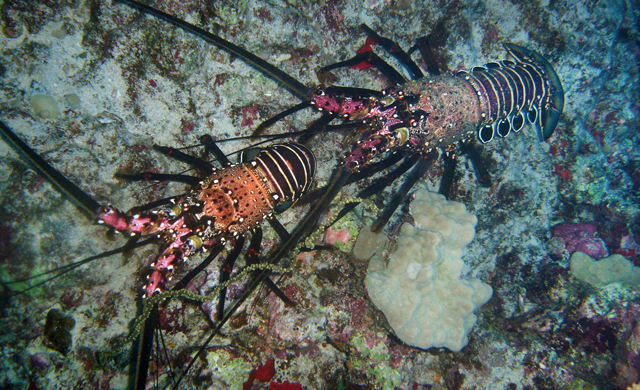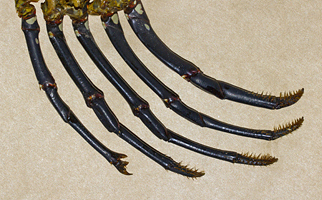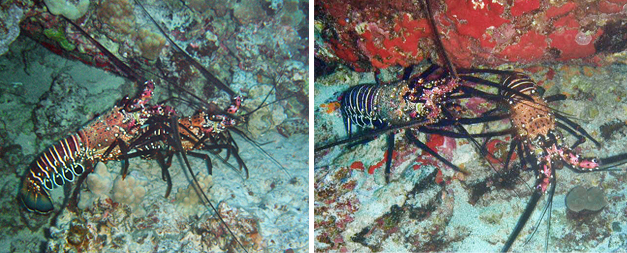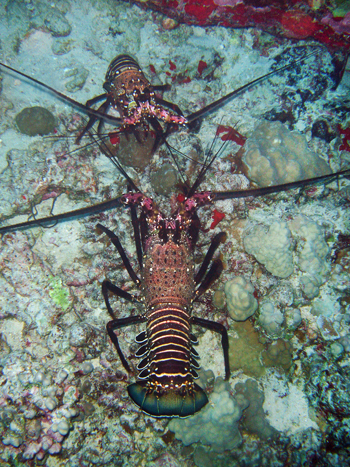
A male Banded Spiny Lobster (Panulirus marginatus) gently grasping at a female Banded Spiny Lobster. Photo: P. Fiene.
The other day we stumbled upon two Banded Spiny Lobsters (Panulirus marginatus) walking around in broad daylight. Lobsters of all kinds are mostly active at night, so it’s kind of exciting for us to see them out in the open during the day. One of the lobsters was walking out front and the following lobster was gently grasping at it with its long front legs.

The five left-side legs of a female Banded Spiny Lobster molt. The 5th (last) pair of legs ends in a pincher in the females only. Photo: P. Fiene.
It was easy to see that the leading lobster was a female because her last pair of legs had a tiny pincher on the end. Female lobsters have this pincher so that they can manipulate the sperm packet from the male and so that they can care for their eggs when they are developing on the underside of their tail.
It was also easy to see that the following lobster was a male. He had no such pinchers and his front legs were very long.

A male Banded Spiny Lobster gently tries to grasp a female, but just as he almost has a hold on her she pulls away and backs up to a rock. Left photo: P. Fiene. Right photo: Billy Meldi.
Who knows how long this had been going on prior to our arrival. We watched them for about 15 minutes. Every time the male would almost get the female in his grasp she would give a little burst of energy and pull away.

Male (foreground) and female Banded Spiny Lobsters come face to face after female backs up to a rock and he has no way to get behind her. Photo: P. Fiene
Finally she walked to a crevice and pivoted to face him. Now they were face to face. The large, more touch-sensing, defensive antennae were spread out toward the sides. And the smaller forked pair of antennules were engaged in chemical/pheromone reception – in other words sniffing. Lobster urine contains sex-specific pheromones, and since the urine is released from the facial area, they were likely learning valuable information about each other while face to face.
It seemed pretty clear to me: the female needed some meaningful conversation before jumping into anything. Basic courtship 101 :-).
Written by Pauline Fiene. Photos as credited.
*************************
Some interesting papers on mating/social behavior of other species of spiny lobster. Comparatively little research has been done on the behavior of our endemic Hawaiian species, Panulirus marginatus.
Horner AJ, Nickles SP, Weissburg MJ, Derby CD (2006) Source and specificity of chemical cues mediating shelter preference of Caribbean spiny lobsters (Panulirus argus). Biol Bull 211:128–139.
https://academic.oup.com/icesjms/article/72/suppl_1/i101/615695
https://academic.oup.com/jcb/article-abstract/3/2/217/2327911
https://www.sciencedirect.com/science/article/pii/0022098185901261
https://pdfs.semanticscholar.org/5067/2095ed4ea89c7597c287cd2a96dbf07019e0.pdf

Comments 1
Thanks Pauline!